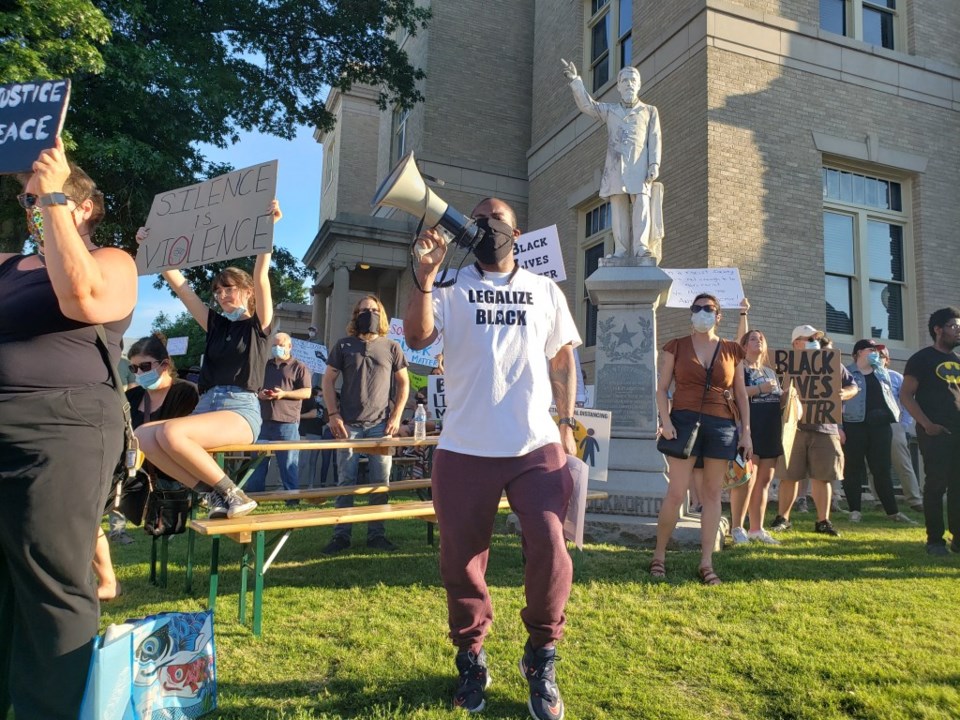Over the past couple of months, the McKinney Throckmorton Statue Advisory Board members have been debating what to do about McKinney native and former Texas Gov. James W. Throckmorton's statue in front of city hall.
In past meetings, they have discussed Throckmorton's history as a Confederate general in the Civil War. They have examined his run as the governor of Texas, including his resistance to ratifying the 14th and 15th amendments, and touched upon the controversy and feelings of deep hurt that surround the controversial statue. Then they discussed options for the statue, for example where it could be moved and what the permit process would look like.
On Thursday afternoon, members of the public were given an opportunity to share their feelings. One facet of the community wants the statue to remain in place while the other would like to see it moved to another location and replaced by a monument to another McKinney citizen of note.
Approximately 1,800 people replied to the online platform with comments about what should be done. Fewer people were allowed inside and each was only allowed three minutes to speak.
To those who have followed the issue, the public comments offered no particularly new insights or information. It was simply a chance for the community to speak to the advisory board, which plans to present its recommendations Tuesday to the McKinney City Council, and have their voices heard. Through the process, these key takeaways came to the forefront:
Throckmorton’s statue is one of the last standing in metropolitan DFW
“James Throckmorton was a complex figure,” one speaker said. He is in favor of moving the statue to his grave site where he could be honored there. He also noted that this statue is the last standing in the DFW metroplex. Other statues with Confederate ties in other major DFW area cities have been removed, specifically monuments in Dallas and Denton.
While Throckmorton's statue is the last to remain in a metropolitan area of DFW, it is not the last one in the Collin County area. Farmersville has a monument of a Confederate soldier, which the community allowed to remain.
The Throckmorton Statue could be legally moved to Pecan Grove Cemetery
The people who want to see the statue moved have pinned their hopes on Historic Pecan Grove Cemetery, where Throckmorton rests today and where he could be honored by those who remember his legacy.
Last night, the board brought up a concern that perhaps the statue could not be moved to the cemetery because it was private land. The statue is currently on public land. However, as a McKinney arts official clarifies, it could be moved there as long as the location was in public view. In initial conversations, the Texas Historical Commission has said that the cemetery should suffice.
Everyone wants to preserve history
But not everyone agrees on what that history tells us, or how we respond to it.
“History cannot hurt you,” said one of the early speakers, who's in favor of keeping the statue downtown. “It’s something we learn from.” He implored the board not to erase history by removing the statue.
Another speaker said that we do not have the right to look back now and judge “our elders” and asked if grandchildren should be allowed to judge the lives and actions of their grandparents. They lived in Texas before there was air conditioning, he said wryly, and we can’t hold them to our standards.
But one of the next McKinney residents used a similar argument to argue the opposite point, saying that Throckmorton’s poor history should not be forgotten or erased. “We all know that he staunchly opposed the 14th amendment," he said. "It’s clear to me that he is a racist."
In fact, two speakers of opposite perspectives brought the same historical book from the 1930s to prove different points. One man lauded Throckmorton for bringing the railroad to Collin County, revolutionizing the area. Later, a woman used the same book as evidence of the ways that Throckmorton established racist systems in Texas government.
The board will now be allowed to offer opinions
McKinney City Council is aware of frustrations and tensions surrounding this issue. In light of the three meetings held so far, they have offered the board a new chance to have their say. While at first the board was only allowed to present research, they may also provide two recommendations: one for moving the statue and one for keeping it in place and possibly adding a plaque with further context to the statue.
Following public comments, the board split in to their respective camps, and each elected one representative to state their case to the council regarding the statue's fate.
Of the 11 board members, five are in favor of removing and relocating the statue and six are in favor of letting it remain in the square. Justin Beller was nominated to present the case for moving the statue to a new location. Judge Nathan White will present the case for keeping the statue on the square.
The decision rests with the McKinney City Council
On Tuesday, the city council will receive a report from city staff with the two opinions presented by two sides of the board.
The final question that was asked was one of compromise — is there a way to find a balance between two very disparate positions? One such compromise was proposed by a speaker near the end of the board meeting: place the statue in the Collin County History Museum, a venue just down Virginia Street from the courthouse, a venue that was made for preservation of Collin County history.
The board still has hope for a resolution that satisfies everyone, a decision that will do McKinney good in the long run.
However, the decision is the council's to make.




